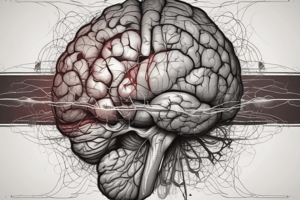Podcast
Questions and Answers
What is a significant cause of death and disability mentioned in the text?
What is a significant cause of death and disability mentioned in the text?
- Degenerative diseases of the brain
- Genetic disorders of the nervous system
- Infection of the spinal cord
- Trauma to the brain and spinal cord (correct)
What is the effect of the severity and site of injury on the outcome?
What is the effect of the severity and site of injury on the outcome?
- It affects the outcome (correct)
- It only affects the recovery time
- It has no impact on the outcome
- It only affects the severity of the injury
What type of injury may cause an open or a closed injury?
What type of injury may cause an open or a closed injury?
- A blow to the neck
- A blunt blow to the head (correct)
- A penetrating blow to the head
- A severe blow to the spine
What can occur in the absence of external signs of head injury?
What can occur in the absence of external signs of head injury?
What type of injury can occur at the site of impact or opposite the site of impact?
What type of injury can occur at the site of impact or opposite the site of impact?
What is caused by rapid tissue displacement, disruption of vascular channels, and subsequent hemorrhage, tissue injury, and edema?
What is caused by rapid tissue displacement, disruption of vascular channels, and subsequent hemorrhage, tissue injury, and edema?
What is the shape of contusions?
What is the shape of contusions?
What appears as depressed, retracted, yellowish brown patches involving the crests of gyri?
What appears as depressed, retracted, yellowish brown patches involving the crests of gyri?
What is the result of CNS trauma directly disrupting vessel walls?
What is the result of CNS trauma directly disrupting vessel walls?
What is the possible location of hemorrhage due to traumatic vascular injury?
What is the possible location of hemorrhage due to traumatic vascular injury?
Where do subarachnoid and intraparenchymal hemorrhages most often occur?
Where do subarachnoid and intraparenchymal hemorrhages most often occur?
Which vessel is most vulnerable to traumatic injury in epidural hematomas?
Which vessel is most vulnerable to traumatic injury in epidural hematomas?
Why do tears involving dural vessels almost always stem from skull fractures in children and adults?
Why do tears involving dural vessels almost always stem from skull fractures in children and adults?
What is the typical outcome of an epidural hematoma if left untreated?
What is the typical outcome of an epidural hematoma if left untreated?
What type of injury can cause a tear in a vessel, even in the absence of a skull fracture, in infants?
What type of injury can cause a tear in a vessel, even in the absence of a skull fracture, in infants?
What is the typical time frame for the manifestation of subdural hematomas?
What is the typical time frame for the manifestation of subdural hematomas?
What is the most common location of subdural hematomas?
What is the most common location of subdural hematomas?
What is the characteristic appearance of an acute subdural hematoma?
What is the characteristic appearance of an acute subdural hematoma?
What is the typical cause of neurologic signs in subdural hematomas?
What is the typical cause of neurologic signs in subdural hematomas?
What is the characteristic progression of neurologic signs in subdural hematomas?
What is the characteristic progression of neurologic signs in subdural hematomas?
Flashcards are hidden until you start studying
Study Notes
Trauma to the Central Nervous System
- Trauma to the brain and spinal cord is a significant cause of death and disability.
- The severity and site of injury affect the outcome, with injuries to the brain stem often being fatal.
Types of Head Injuries
- Injuries can be penetrating or blunt, and may cause open or closed injuries.
- Severe brain damage can occur without external signs of head injury.
Traumatic Parenchymal Injuries
- Brain injury can occur at the site of impact (coup injury) or opposite the site of impact (contrecoup injury).
- Contusions are caused by rapid tissue displacement, disruption of vascular channels, and subsequent hemorrhage, tissue injury, and edema.
- Contusions are common in regions of the brain overlying rough and irregular inner skull surfaces, such as the orbitofrontal regions and the temporal lobe tips.
Morphology of Contusions
- Contusions are wedge-shaped, with the widest aspect closest to the point of impact.
- Within a few hours of injury, blood extravasates throughout the involved tissue, across the width of the cerebral cortex, and into the white matter and subarachnoid spaces.
- Old traumatic lesions appear as depressed, retracted, yellowish brown patches involving the crests of gyri.
Traumatic Vascular Injury
- CNS trauma often directly disrupts vessel walls, leading to hemorrhage.
- Hemorrhage may be epidural, subdural, subarachnoid, or intraparenchymal, occurring alone or in combination.
Epidural Hematoma
- Epidural hematomas occur when dural vessels, especially the middle meningeal artery, are torn due to traumatic injury.
- In infants, traumatic displacement of the easily deformable skull may tear a vessel, even in the absence of a skull fracture.
- Epidural hematomas compress the brain surface and constitute a neurosurgical emergency.
Subdural Hematoma
- Rapid movement of the brain during trauma can tear the bridging veins, producing bleeding into the subdural space.
- Subdural hematomas typically become manifest within the first 48 hours after injury.
- They are most common over the lateral aspects of the cerebral hemispheres and may be bilateral.
- Neurologic signs are attributable to the pressure exerted on the adjacent brain.
Studying That Suits You
Use AI to generate personalized quizzes and flashcards to suit your learning preferences.




